Nowadays we think of it as the pre-mullet era of Superman, but at the time The Death of Superman was an incredibly big idea for DC. A story which killed off their main signature hero was not only an eventual inevitability, but also an idea which would actually have some resonance for the company. Superman is rightfully viewed as an inspirational ideal, both in the pages of the comics and in the real world – killing him, really, would have an impact no matter how well the story turned out. And his death became a slight watershed moment for DC as a company, leading them down a misery well which soon after broke Batman’s back and blew up Green Lantern’s hometown.
But anyway, the story itself. How did that turn out? DC have collected a new trade paperback of the seven-part storyline, so finally I have a chance to find out.
The main thing I took away from the storyline is that Supergirl’s continuity must be incredibly weird. She makes several appearances during this storyline which suggest she is living with a bearded version of Lex Luthor, who keeps her at home like a pet kryptonian. When she finally does race into battle her face gets smooshed and she turned into a purple worm thing. WHAT
Let me set the scene though, before we return to whatever the hell is going on with Supergirl. Doomsday is a cleverly mindless invention, a character who emerges from nowhere, never talks, and seems intent on destroying everything he sees. Rather than a tactically aware or capable enemy, Doomsday is a giant rock person who punches and smashes anything you put in front of him, without any agenda or interest in the damage he causes. He exists simply to destroy – he’s the definition of everything Superman fights against.
So Doomsday emerges from what appears to be a metal box buried two feet deep in the Earth, and promptly goes berserk, crushing canaries (in a typically Louise Simonson moment) and blowing things up. A team of local heroes go to fight him, he trashes them, Superman shows up, they fight to a standstill, then various other heroes show up/get knocked out while Superman and Doomsday continue their fight. It’s a rampage storyline above all else, but what struck me most is how many ideas are thrown into what at first looks like a mindless battle sequence spread over seven issues. Although don’t worry! There is still some mindless battle!
Rather than just allow the storyline to be a rumble with a winner and loser, DC’s writing team (made up of Roger Stern, Dan Jurgens, Simonson, Jerry Ordway and others) take advantage of their ending. If Superman is going to die at the hands of a fierce and powerful enemy, then they can take the gloves off and cause some additional damage along the way. And so we get interesting – if distinctly dated at times – diversions to a family house, where Superman has to decide between allowing Doomsday to run off, or save a family from a fire. Normally this isn’t a decision at all – Superman will go save them, of course he will. But with the stakes suddenly inflated by the fact he’s going to die in this story, suddenly it’s far harder to predict what Mr Kent is going to do.
Perhaps because the gloves have come off, there’s a heightened sense of tension which the creative team could never play off in a regular, non-mortal storyline. This also extends to the supporting characters, including Guy Gardner, Maxima and Blue Beetle. Usually you would expect the characters to get beaten up to show off Doomsday, but ultimately all remain safe. The higher stakes changes that though, and the brutal beatings they receive seem far more dangerous and scary. If I were seven when I read this, I’d be pretty scared. The art – which is for the most part great – plays off on this.
There are several sequences where the horror of a scene is suddenly played up unexpectedly, with every action becoming far more ominous and brutal. There’s a sequence pencilled by Jurgens in the second issue in which Blue Beetle is beaten up and then falls through the air. Rather than being caught and saved by ‘Bloodwynd’ (again, WHAT?) before he hits the ground, Doomsday knocks Bloodwynd to the ground. We then watch in a three panel sequence as Beetle silently falls to the ground and is horrifyingly injured. Judgens sequences these three panels on top of one another to emphasise the extended tension of the fall, as readers realise nobody is going to save the character. It’s a beautiful piece of storytelling, especially in a storyline where I wasn’t expecting much subtlety.
The last issue of the story is where DC get a little bit silly, with an all-splash finale which has about twenty full-page splashes one after another. This slows down the battle to a ridiculous degree, and forces the storytelling to jump between moments arbitrarily. Some of the artistic choices here are well-done – we don’t see the final blows land, but we see the impact reflected in Lois Lane’s camera – while some are more clunky and difficult to interpret. There’s an impact in escalating the size of each page, and I’m surprised DC didn’t decide to have the last double-page sequence spread out into an A3 fold-out which could cover the whole of your wall. It’s also very silly. Lois’ hair alone makes the book worth it.
Death of Superman is a lot more fun than I was expecting it to be, with some total nonsense in the subplots vying with some pretty strong storytelling and a simple, if well-done, central narrative. It’s not a cerebral masterpiece which tests Superman as an ideal – it’s a story where an awfully-designed rock monster punches a lot of things, some of them Superman, before getting punched back and dying. But for all that, this trade collects a story which could have been a complete mess, and shows off a coherent piece of work which DC planned carefully.
The trade collects only the battle and death, which means I have yet to see how DC followed up on this. A lot of the story hinges upon the ideas that Superman’s death will be meaningful and important in the long-term – just look at the cover, which makes a simple image resonant and moving. I have no idea if DC were able to follow up on that, but there is an immense amount of promise left for readers by the time Superman finally conks it.
This was a publicity stunt which arguably opened the doors for the constant cycle of death-resurrection which plagued comics throughout the latter nineties and new millennium. But at the same time there’s a sequence where Booster Gold gets his head slammed in a car door.
So it can’t be all bad.


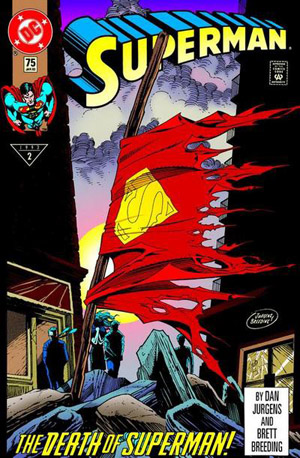
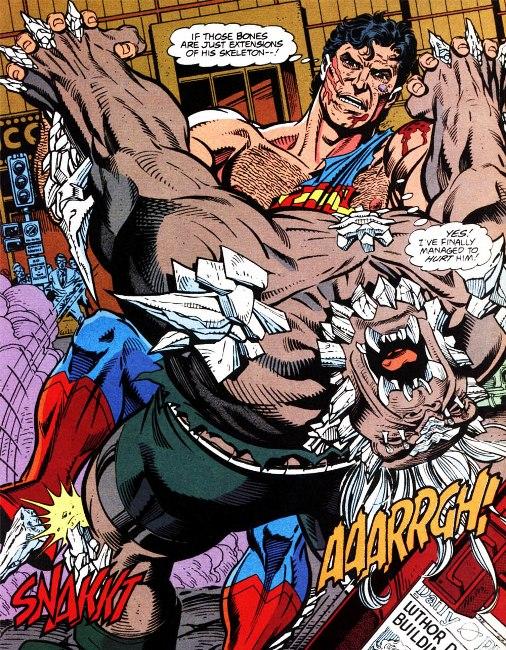
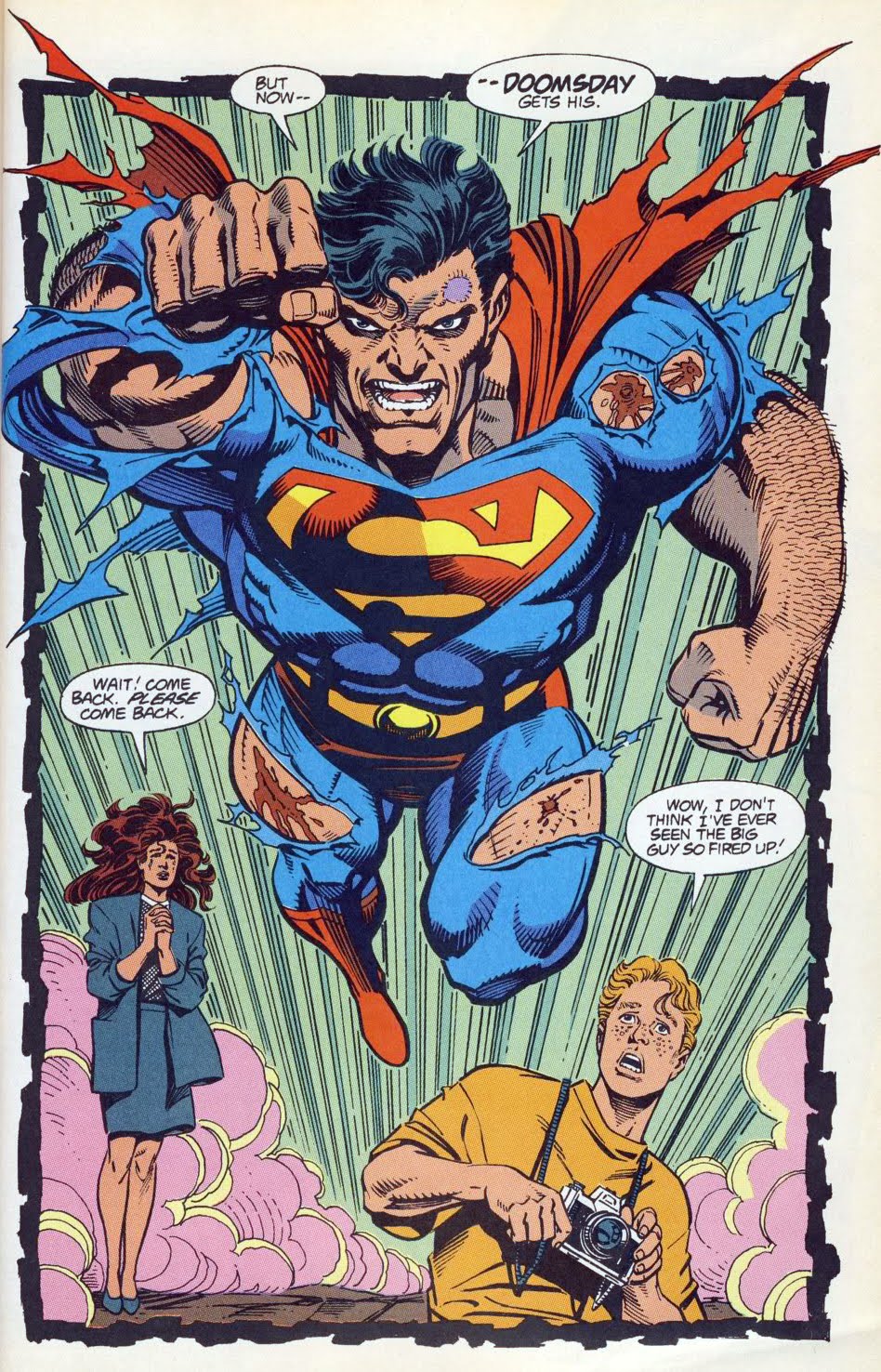
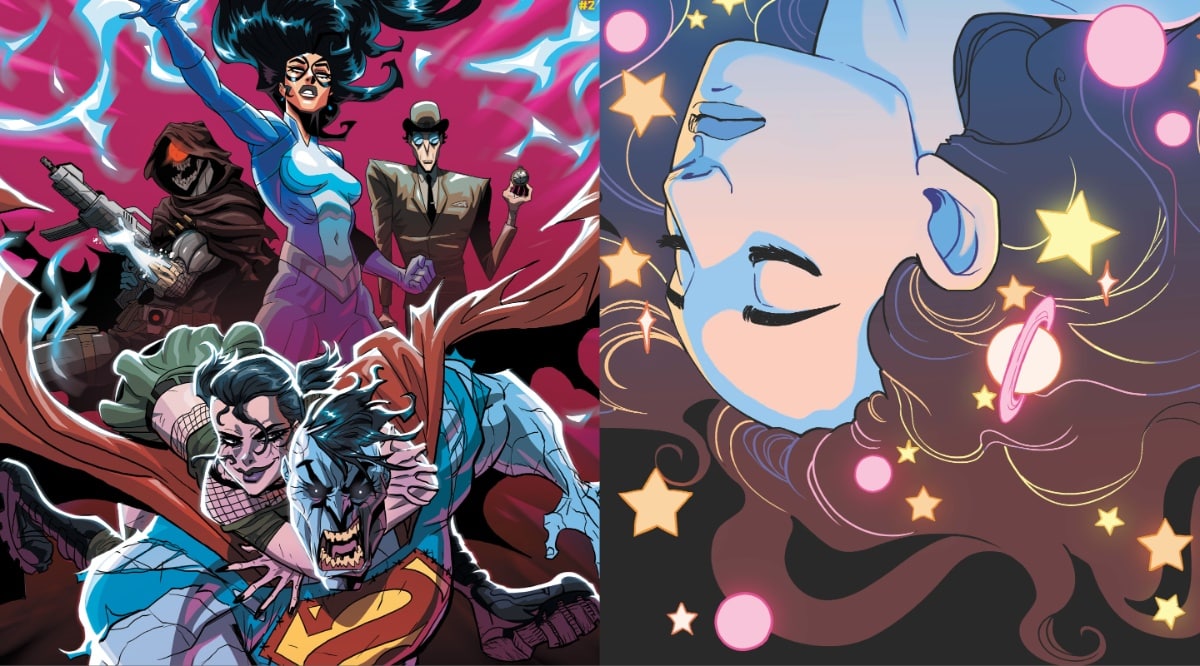
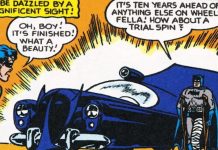



Doomsday’s design with the protruding bones is actually pretty great. There’s no face to be saved with irony after already saying you were entertained by the story.
I really liked that after the Ordawy and Grummett’s issue, that has a 4 panel grid, eahc following issue loses a panel per page, the following issue has a 3 panel grid, then the next a 2 panel grid until the final issue is just 1 panel per page… :)
Interesting perspective — though makes me feel old. Death of Superman actually got me into comics again after a lapse while in college sampling “real life.” There will never be event superhero comics like that — on the front page of the newspaper, on TV — hunting down those issues in bookstores and malls was a quest. Knightfall was almost as big — but only almost. So there was a whole context (you already knew the ending) that made it very dramatic. And loved Doomsday because they refused to reveal anything about him in the actual story — that was new. And no matter what people may say now, there was a palpable fear that he wouldn’t come back. This was certainly the first of the modern death/resurrection bits and things were still unsteady — and thrilling — in those days. I remember there was a lot of anger (“How could they??”) — very surreal and cool.
i remember everybody freaking out over superman’s “death”, especially the news media, many of whom did not read superman comics (or any comics for that matter). i thought it was a fun read and all the fans knew that eventually clark would be making a return sooner or later.
@ brad ricca: funny how you bring up fans being pissed that dc killed off clark. i remember some fans being angered when dc was going to bring superman back. as far as they were concerned dead is dead, and to kill off superman, then resurrect the character was a stunt of the cheapest order. i wonder if those folks after the deaths and rebirths of bucky, thor, captain america, hawkeye, mr.fantastic, the human torch, mockingbird, hellcat, the wasp, the flash, supergirl, batman, hal jordan, aunt may, or the yet to return peter parker, are still reading after all those “cheap stunts”.
I remember that this even made the news in Norway, something that was unheard of at that time. Nobody cared about comics, and Norwegian comic publishers had at that time given up publishing both DC and Marvel comics (Spider-Man might have survived up until 1994, I’m not sure).
I have read my copy of the trade a few times since this happened and there are some cool moments, but they are isolated to a few pages, even panels. You can read the entire arc in 30 minutes…it is not an imaginative story at all. It sucks, really. I’ll stop there.
The media hype around this was something else.
@abc — yeah, that’s what I was trying to say, thanks — that this was the first of these stunts and thus had a different feel to it, at least in the beginning. Everything after was/is a duplicate of the same formula, more or less. Remember the black armband??? I remember being surprised that Clark came back so soon — though the storyline with Coast City, GL, and Mongul was pretty cool. And the original storyline may not hold up (or it may), but it really did some different things for superhero comics — unknown villain, strange layout, etc. Very brutal, too.
The “Death” story was OK. The “Funeral” and “Supermen” stories were better… even though I really wish they’d had the balls to do what they claimed they were doing, and permanently replace the character with the four reinvented versions. Hey, Warner: never mind 50,000 aging fanboys grousing about the fact that the current version doesn’t have red shorts … (give them an old-timey series set in the 1960s or whatever, and split the profits on that with the Siegel and Shuster families), and create a new Superman (or four) that could appeal to new audiences.
I really liked this storyline way back when, but in retrospect the subsequent World Without a Superman stories were much better. The actual death of a character is a simple thing ultimately (well until the point where they reveal that they weren’t ACTUALLY dead and were instead shot back in time with a magic bullet while their body was replaced with a simulacrum), but the post death stories of characters are always very emotional and complex. I remember there was one story in the Funeral for a Friend arc where the Justice League answered superman’s christmas requests and it took all of them to accomplish what superman could do in one night (like Santy Clause!). It’s one of the cheesier pre-crisis (and I mean pre-1985-crisis) notions of how Superman spends his time, but the execution was well written and very touching.
And to clarify what’s what in the article up yonder:
Bloodwynd was actually the Martian Manhunter in disguise. I honestly cannot remember why. I think it had something to do with Guy Gardner being a dick.
Supergirl was IIRC an alien called Matrix whose real form was purply goo. Superman found her and brought her to John and Martha Kent to raise. Hoping to emulate clark she/it became Supergirl and somehow stupidly fell for-
Lex Luthor Junior. Lex Luthor (who i believe was thought to be dead at this point. it’s all kinda hazy) decided to return to his town and his business empire disguised as his as-yet-never-seen-son. I guess the conceit in Metropolis was “Hey! he can’t be evil. This Lex Luthor has hair!”
Seeing this story unfold in real time was marvelous, especially the aftermath. Even with the knowledge that the original Superman would return, there was a sense that everything was askew and anything could happen.
The same goes for other epic (or would-be epic) storylines of the mid- to late-90s. It’s easy to poke fun now, but even arcs such as the Spider-Man clone saga or Superman Red/Superman Blue were taking chances in ways that were interesting, if not always critical successes or on-brand. I suppose the closest analogs today are things like Grant Morrison’s Batman and Dan Slott’s Superior Spider-Man.
Seeing this story unfold in real time was marvelous, especially the aftermath. Even with the knowledge that the original Superman would return, there was a sense that everything was askew and anything could happen.
The same goes for other epic (or would-be epic) storylines of the mid- to late-90s. It’s easy to poke fun now, but even arcs such as the Spider-Man clone saga or Superman Red/Superman Blue were taking chances in ways that were interesting, if not always critical successes or on-brand. I suppose the closest analogs today are things like Grant Morrison’s Batman and Dan Slott’s Superior Spider-Man.
Never really thought much of the Death storyline but really enjoyed Funeral for a Friend.
I still remember Mike Carlin giving an interview in one of the catalogs like Diamond Previews or one of the others in which he lied through his teeth and said “The Death of Superman is not a gimmick.” It was a gimmick which lasted about a year until his inevitable return. Both DC and Marvel then got on the kill off a character and then bring him back bandwagon with Martian Manhunter, Captain America, the Human Torch and now Spider-Man. I don’t know why anyone believed that DC would kill off its signature character and not bring him back. Even the version of Robin who died in the 1980s in the “Death In The Family” storyline was brought back, just not right away. They make these big changes and then months later undo them. In Civil War Spider-Man’s identity was revealed to the world and Marvel claimed that this was the new “status quo”, which it was for one year. None of it means anything. Rather than tell interesting stories they just keep coming up with short-term gimmicks.
Comments are closed.